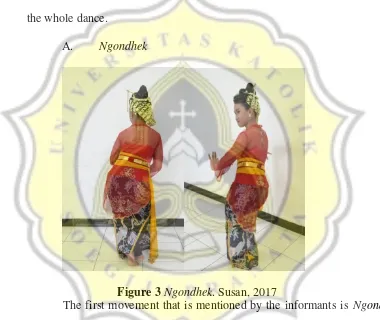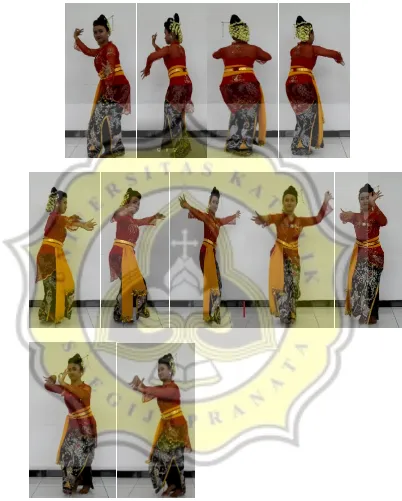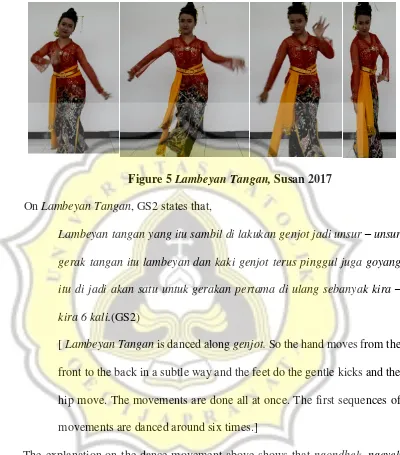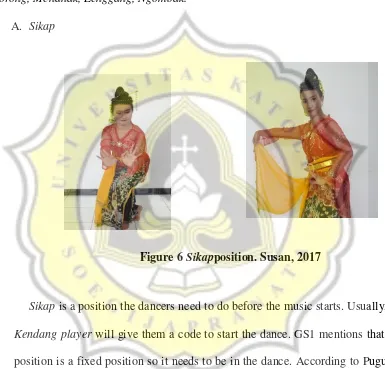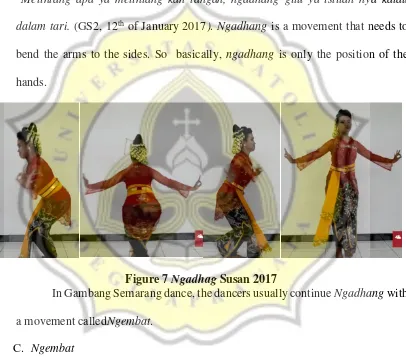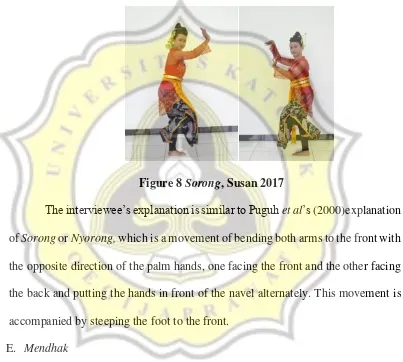documented the movements and details related to the research object and finally, the researcher did some studies from book, journal and online source in order to make the conclusion from the data that has been collected.
CHAPTER IV
DATA ANALYSIS AND INTERPRETATION
and the second one isthe meanings of Gambang Semarang dance movement. To answer these research questions, the writer dida qualitative research by observing and interviewing 6 informants. They are two Gambang Semarang dancers, a historian who wrote about Gambang Semarang, a dance choreographer and owner of a dance company in Semarang, a dance teacher in Sanggar Greget and a dance teacher in Sobokartti
During the interviews, the writer ecountered some dificulities during gathering the data. For example, with the first two dancers, the writer also took the pictures and videos about the dance. Initially, the writer took pictures and video during the real performance of Gambang Semarang dance. However, the result is not as good as the writer expected. When the writer watched the real performance of Gambang Semarang dance, the dance was performed inanopen space with many other people watching. Unlike western type of performance where the audience is sitting in arranged seats and watching, Gambang Semarang dance is a Javanese folk performance where the audience stands and moves around freely. As a result, during the recording, some people passed by or even blocked the recording process (see appendix of the first video). Finally, the writer decided to record the dance movement separately to catch the detail of the dance movement. In pictures and the video were taken during the interview with the dancer.
interview was held on the 12th of January 2017. There are two people who were interviewed by the writer and because of ethic policy–the writer wills use a code name for each person. The first dancer will be GS1 and the second dancer will be GS2. The second interview was held on 2nd of May 2017. The code name of this person is GS3 and the 3rd interviewheld on the 20th of May 2017 in Sobokartti. The code name for this person is GS4. And for the last participant, he will be getting GS5 as the name code. The interview held on the 8th of April 2017.
Finding the informants who really know about Gambang Semarang is not as easy as the writer thought it would be. Some of the informants were not really cooperative. One of them did not really want to answers the question and most of them did not really know about the meaning behind the dance movements. They said that the dance movements have no meaning at all. They stated that the dance movements are only for entertainment purposes; to entertain people who watch the performance. The writer also struggled to find a potential key informant, who is said to be the personwho inherits the “original” Gambang Semarang dance from the creator. The writer came to the house that people believed it could be her house but it turned out that this informant has already movedout.When the writer tried to find out where she moved by asking the people around her former house, no one seemed to know where the informant moved to.
movements and important movements and their meanings in Gambang Semarang dance.
4.1Description of Gambang Semarang dance movements
The data collected during the interviews with the informants, GS1 and GS2 reveal that Gambang Semarang covers several main movements. They are Ngondhek, Ngeyek, Genjot and Lambeyan Tangan. The participants also
mention several supporting movements in the dance such as Sikap, Lenggang, Ngadhang, Ngembat, Ngombak, Sorong, Mendhak. Compared to the data
collected by Puguh et al (2000)about Gambang Semarang movement, interviews with the participants present different findings. While the writer’s informants mention four main dance movements (Ngondhek, Ngeyek, Genjot and Lambeyan Tangan), Puguh et al mentions three main movements in Gambang Semarang dance (Ngeyek, Ngondhek, and Genjot).Conversely, the writer’s informants mention less number of supporting movements compared
to Puguh et al’s findings.The supporting movements mentioned by Puguhet
alare mlampah glebagan, nyembah, ngeyek nekuk asta, ngondhek jongkok
nekuk asta, nawang seblak, genjot seblak, nyorong mekar, ngeyek ukel rikma, mlampah ngawe asta, and nyembah. (Puguh, Penataan Kesenian Gambang Semarang Sebagai Identitas Budaya Semarang, 2000, p. 104).
4.2Gambang Semarang main dance movements
Gambang Semarang main dance movements basically emphasize hip movements with head and hand movements. For hand movements, particularly in the finger position, Gambang Semarang Arts Company has a very specific and symbolic finger position called Linggar. This finger position is posed in the whole dance.
A. Ngondhek
Figure 3 Ngondhek. Susan, 2017
Gitu jadi lele yang bergoyang itu kan gerakannya em agak meliuk liuk
dan agak halus gitu.
[Ngondhek is a movement which focus on the hip. The movement is quite coarse and it resembles number 8. My coach said that the movement is like a wriggling catfish. So, when a catfish wriggles, the moves are wriggly and subtle.] (GS2, 12th of January 2017)
As seen in the transcript of the interview, GS2 informed that her coach once told her that the movement of Ngondek resembles movement of a wriggly and subtle movement of a catfish. The movement emphasizes on the hip movements. The emphasis on the hip movements differentiates this movement with any other movement from another region. The hip movement in Gambang Semarang acts as the signature movement of the dance. In the other sequence of Ngondhek, is also a hip movement but with different style. It means that both hands are placedin the hip and then swing the hip to the left and to the right and the dancers do another pose as the song starts to change. She mentioned later that her coach told her thatthe movement represents a typical Semarang dance which is “strong”, “… salah satu penggambaran karakter Semarang juga kuatnya… [one of the represenetations of Semarang characteristic is as strong as…].”
Ngondhek jongkok ukel asta, is a hip movement that swing side to side. The movement also requires the dancers to place the right hand in front of the navel and bending the left hand in front of the navel.The movement startsfrom standing then squating and back to the standing pose. (Puguh, Penataan Kesenian Gambang Semarang Sebagai Identitas Budaya Semarang, 2000)– See video attached. Unfortunately, there is no further information about the name difference since the informants could not provide any other information.
B. Ngeyek
Figure 4 Ngeyek , Susan 2017
right feet is in front of the left feet. Right hand is menthang to the right side with the fingers docked; the wrist bends up and down alternately, meanwhile the left hand bends to the side of the left hip.
C. Genjot
Interviews with the participants reveals that Genjot is a movement that focuses on eyes and the dancers need to keep their head straight to the front and swing the body to the left and to the right. According to GS1, Genjot comes in the beginning, in the middle and the movement that comes after is a movement that is close to Semarangan movement. She also mentions that the movement that comes after Genjot is a combination between hip and head movements. This movement is repetitive so it will always be danced in Gambang Semarang.
However, GS1 says that, even though genjot is a repetitive movement, there are still some differences in the dance. She mentions that the first movement only uses the hand movement and then for the other movements in the sequences also hand movements but combined with head movement. She said, the sequence is using hip, both hands, and head and then connected with the shoulders. So the head, hip, hands, and shoulders are connected to one another.
right. Those movements are combined to be the first movement in Gambang Semarang. An informant says that the first movement needs to be danced at least 6 times.
Puguh et al (2000) in their research also mentionsthis movement, but they use a different name, which is Genjot seblak. According to Puguh et al, Genjot Seblak is a hip movement that swing side to side, accompanied by tiptoe steps
and ends with placing the hand in lembehan following the footsteps. (Puguh, Penataan Kesenian Gambang Semarang Sebagai Identitas Budaya Semarang, 2000) – See video attached
Figure 5 Lambeyan Tangan, Susan 2017 On Lambeyan Tangan, GS2 states that,
Lambeyan tangan yang itu sambil di lakukan genjot jadi unsur – unsur
gerak tangan itu lambeyan dan kaki genjot terus pinggul juga goyang itu di jadi akan satu untuk gerakan pertama di ulang sebanyak kira –
kira 6 kali.(GS2)
[ Lambeyan Tangan is danced along genjot. So the hand moves from the front to the back in a subtle way and the feet do the gentle kicks and the hip move. The movements are done all at once. The first sequences of movements are danced around six times.]
The explanation on the dance movement above shows that ngondhek, ngeyek and genjot are almost similar to each other. They are different only in details.
4.2.1 Additional dance movements in Gambang Semarang
The second part of the discussion about Gambang Semarang dance movement is the additional movements. Those movements are Sikap, Ngadhang, Ngembat, Sorong, Mendhak, Lenggang, Ngombak.
A. Sikap
Sikap is a position the dancers need to do before the music starts. Usually, the
Kendang player will give them a code to start the dance. GS1 mentions that this position is a fixed position so it needs to be in the dance. According to Puguh et al, Sikap is a position that requires the dancers to bend their knees or mendhak. The dancers move the feet to the rear side then tilt it for 30 degrees with curl up the toes. The dancers also inflate their chest and lean their body upward for more and less 15 degrees. When seen from the side, the position of the body forms a
straight line and a bend. This pose is similar to a standing pose from Javanese Dance, Surakarta version (Puguh et al, 2000).
B. Ngadhang
Ngadhang, in GS2’s explanation is atraversing or bending the arms, “Melintang apa ya melintang kan tangan, ngadhang gitu ya istilah nya kalau
dalam tari. (GS2, 12th of January 2017). Ngadhang is a movement that needs to bend the arms to the sides. So basically, ngadhang is only the position of the hands.
Figure 7 Ngadhag Susan 2017
In Gambang Semarang dance, the dancers usually continue Ngadhang with a movement calledNgembat.
C. Ngembat
Ngembat itu kita dengan khasnya kita itu em jadi ngembatnya itu ada
alurnya gitu jadi alurnya mungkin bisa di jelaskan di video tari alurnya agak berbeda, yang satu naik keatas, dan yang lainnya berputar gitu. Jadi
itu juga salah satu gerak yang harus mengsinkronisasi antara ya otak dan gerakan tangan gitu.(GS1, 12th of January 2017)
[The specialty of ngembat is the groove. So, the grooves might be explained in the dance video. It’s kind of different one is going up and the
other one is spinning. So, that’s also one of the movements that have to
synchronize the brain and the hands movement.]
As it is difficult to capture ngembat movement in still pictures, the example of the movement can only be seen in the attached video. (Tari Gambang Semarang 1:25 – 1:33)
D. Sorong
The interviewees say that the first movement in Sorong is walking to the front and then twirls the body and walking to the back and as the closing the dancers will do a courteous pose like lie the back of the hand downward. She mentions that Gambang Semarang is always repeating the movements that are in the dance.
[First of all, step to the front then twirl and step to the back. Then as the closing, they do a respect gesture. With the hands position are facing down like this.] (GS2, 12th of January 2017)
Figure 8 Sorong, Susan 2017
The interviewee’s explanation is similar to Puguh et al’s (2000)explanation
of Sorong or Nyorong, which is a movement of bending both arms to the front with the opposite direction of the palm hands, one facing the front and the other facing the back and putting the hands in front of the navel alternately. This movement is accompanied by steeping the foot to the front.
E. Mendhak
Mendhak itu posisi kita menurun apa turun menurunkan apa ya badan
kita kan mendhak itu kan menekukan lutut kita gitu kan ya gitu. Mendhak itu termasuk gerak dasar tari.
[Mendhak is a position that requires the dancers to make their body lower. The dancers should bend their knees. Mendhak is one of the base movements of dance.] (GS1, 12th of January 2017)
Interestingly, although GSAC dance uses the idea of Gambang Semarang dance written by Puguh et al, but the informant GS1 who is a GSAC dancer call the same movement differently. When GS1 calls the movement, mendhak, Puguh et al called the same movement; sikap. In the later interview, the dancer uses the term sikap for different dance movement. There is no further information about the difference since the participants didn’t mention anything about it. According
to the participants, Mendhak is the connector in the Gambang Semarang dance. As it is difficult to capture Mendhak movement in still pictures, the example of the movement can only be seen in the attached video. (Tari Gambang Semarang 0:55 – 0:59)
There are some movements that the participants did not mention in the interview but found in Puguh’s research report. They are Nyembah, a movement that
In general, it can be seen from the discussion that first, Gambang Semarang dance movements are more flexible in its structure compared to classical dance movements which tend to be uniformed. Second, Gambang Semarang is more dynamic while the classical dance is more refine and subtle. Third, Gambang Semarang dance can be modified freely by ordinary people whereas the Classical dance is patent so that it is restricted from modification. Those findings may be the result of the facts that Gambang Semarang is categorized as folkdance, which is more open to modification. The ununiformity of a folkdance is accepted by people.
4.3 Important Movements and Their Meaning in Gambang Semarang Dance This sub-chapter contains the discussion on the meaning of the movements on Gambang Semarang. Along the discussion, the writer found the fact that interviewees, whether they are dancers, dance coaches, or the owner or the manager of a dance group lacks of information of the meaning of dance movements. Only one interviewee shares information of the meaning; he is the owner of Greget Dance Group who happens to be a dance choreographer. Most information received from the interviewees is related to the dance itself. The results of the interviews are quoted as follows.
On the meaning of the dance movements, GS1 does not answered directly. Instead, she states that the movement in the middle of the dance is the most interesting one.
nanti apalagi nih kalau di Gambang Semarang itu salah satu ciri khasnya adalah
tangan. (GS1, 12th of January 2017)
[The most interesting movement in Gambang Semarang is the movement that is in the middle of the dance. For example, Sikap, it is considered as the typical movement of Semarang dance.]
GS1, later says that the difference between the hand movement in Gambang Semarang version and in other version of other regions is in the finger positions.
Kalau ngeyek dan lain sebagainya itu, itu memang, gerakan – gerakan dasar.
Gerakan –gerakan tradisi yang sebelum nya sudah pernah ada. Cuman untuk Gambang Semarang kenapa ada gerakan seperti itu, mungkin itu adalah modifikasi dari gerakan – gerakan tradisi yang sudah ada gitu. (GS1, 12th of January 2017)
[Ngeyek and other movements are indeed the basic movements; the traditional movements that have already existed before. But, for Gambang Semarang, why there is a movement like that maybe that movementis modification from the tradition movements that already existed.] (GS1, 12th of January 2017)
must look at the basic dance movement before making new masterpiece, but during the modification process, the choreographer makes the dance movement more exciting. However, the interviewee failed to mention the meanings of the movements.
Uh huh gitu. Jadi tu gerakan – gerakan modifikasi. Mungkin sebenernya ada sih, kayak semisal tangan tadi itu maksudnya ada arti khususnya aja. Cuman lebih di telusur kesejarah Gambang Semarang sendiri gitu.
[Uh – huh. So, the movements are modified movements. Maybe they have meanings. Like for example, the hands have some meanings. But, I only know the modification based on the history of Gambang Semarang itself.](GS1, 12th of January 2017)
A little information comes to GS2, Similar to GS1, GS2 mentions that the important movements in Gambang Semarang dance are Ngeyek, Ngondhek, Genjot and Lambeyan Tangan. She mentions a movement called Linggar. Linggar is one of the
hand movements in Gambang Semarang performed by GSAC (Gambang Semarang Art Company). The movement includes handmovement that focuses on the fingers. She mentions that the fingers movement symbolizes body, spirit, and soul. Those three things should be synchronize. That synchrony is symbolized with a circle that formed with a thumb and index finger. This also symbolizes life.
… ada satu ciri khas gerakan kita ya itu tangan em ini namanya linggar ya
menurut penelitian yang dulu, jadi ini tu memiliki filosofi. Jadi 3 jari ini tu
sinkron itu di lambangkan dengan bulat yang di bentuk oleh jari telunjuk dan ibu jari
gitu. Jadi ini melambangkan kehidupan juga. Jadi ini tu sepanjang tarian penari harus seperti ini, ga boleh lemes seperti ini (memperagakan) harus terus kaku. Apapun
gerakannya kemana pun arahnya tetep seperti ini, itu khasnya.
[… there is a typical movement of thehands called linggar. According to the
research that has been held, linggar has a philosophy. So, these 3 fingers symbolize our body that consists of body, spirit, and soul. Then the synchronize movements are symbolized with the circle that is shaped by the index fingers and the thumb. So, this also symbolizes life. So, as long as the dance is performed, they (the fingers) should be like this (make a linggar shape) and cannot be limp (demonstrate). It must be stiff still. Whatever themovement and wherever thedirections (of the dancers) are, it should be like this. That’s the characteristic.] (GS2, 12th of January 2017)
GS2 also states the hipmovements in Gambang Semarang are rough and subtle. Compared to Sudanese Jaipong, the hip movements in Central Java are more dynamic and flowing, energetic but yet also subtle. GS2 states that the meaning of the movement is the character of Semarang people, not too aggressive but not too slow. The character of Semarang people can be said as dynamic as can be also felt in the rhythm of the music when the dancers do Ngondhek, Ngeyek, Genjot, and Lambeyan Tangan.
Menurut ini juga ya ke karakter orang Semarang gitu jadi katanya orang Semarang itu kalau mengerjakan sesuatu tu memang pasti mengambil langkah pasti,
pertimbangan gitu jadi tercipta gerak – gerakan seperti itu juga. Tidak kasar tapi ga
halus juga.
[Maybe this is more like to the characteristic of people in Semarang. So people said if Semarang people do something they are always taking certain steps, it not too fast, not in a rush but also not slow. So everything is full of consideration. So then, that movement created. It’s not rough, but also not subtle.](GS2, 12th of January 2017)
Other than the abovementioned meaning, GS2 says that she did not know others. People can feel it only when they dance it as a unity.
The reason for the almost non-existence of the dance movement meaning provides by GS3, the third interviewee who is also Semarang culture researcher. GS3 states that he did not have any information about the meaning nor the philosophy of the dance movements because Gambang Semarang was initially not choreographed as a dance. It is Nyah Sam’s body movement while she was singing Gambang Semarang
song. Nyah Sam is a well-known Gambang Semarang singer in the 60’s and the 70’s. GS3 says that the basic movements focus on the hip and resemble number 8. Those movements are spontaneous movement which is termed by GS3 as Ngibing. It is more like Nyah Sam’s personal style. Because she danced those movements continually,
then people considered it as Gambang Semarang dance movements.
… iya, lha wong, itu kan sebetulnya bukan merupakan sebuah tari yang di
lah. Itu hanya seorang biduan wanita yang gerakan spontannya / ngibingnya itu
seperti apa. Lah karena itu berulang – ulang dan biduan wanita Gambang Semarang itu nyonya sam ya itu dianggap sebagai gerakannya Gambang Semarang ya seperti itu. (GS3 2nd of May 2017)
[… actually it is not a choreographed dance. But it is more like Nyonya Sam’s
personal style when singing Gambang Semarang song. Nyonya Sam danced like that. It is called ngibing. It was a singer whose spontaneous movement or ngibing is like that. And becauserepetitive movements and the singer of Gambang Semarang is Nyonya Sam, so people consider it is as Gambang Semarang dance movements.] (GS3 2nd of May 2017)
Additional information comes from GS5, a choreographer and the owner of a dance group in Semarang.
Tidak ada pembakuan gerakan tari. Menurut Bintang, 3 unsur gerakan seperti
ngondhek yang dulu di lakukan oleh banci– banci itu. Sedang menurut Greget membuat Gerakan berdasarkan kehidupan masyarakat kota semarang. Misalnya
membuat gerakan seperti orang sedang menjala ikan di laut. Kemudian goyangan – goyangan dan sanggulnya semarang kan kaya ndog kremeg, angka 8. Kemudian dari topografi kota semarang adalah perbukitan jadi dari gerakan – gerakan tangan akan
Tentu tidak lepas dari tradisi jogja, solo, melayu dan beberapa atribut cina juga di
pakai. (GS5 8th of April 2017)
[..There is no standardization in the dance movements. According to Bintang, 3 dance elements like Ngondhek are usually danced by the transvestites. Meanwhile, Greget makes the dance movements based on the life in Semarang. For example, it (Greget) made a movement that is quite similar with a fisherman movement when they are fishing in the sea. Then, the movements and the Semarang’s hair bun are like ndog
kremeg, resembling number 8. Then from the topography, Semarang city is quite hilly
so, the hands movements will show the characteristic of highland, lowland, commerce, topology, and climate in Semarang. Moreover, it also shows the daily life of Semarang people working as sellers, farmers, and fishermen. Those daily life activities shown in the movements are not separated from Jogja, Solo, Malay and Chinese tradition.] (GS5 8th of April 2017)
GS5’s explanation of the meaning of dance movements above shows that some
